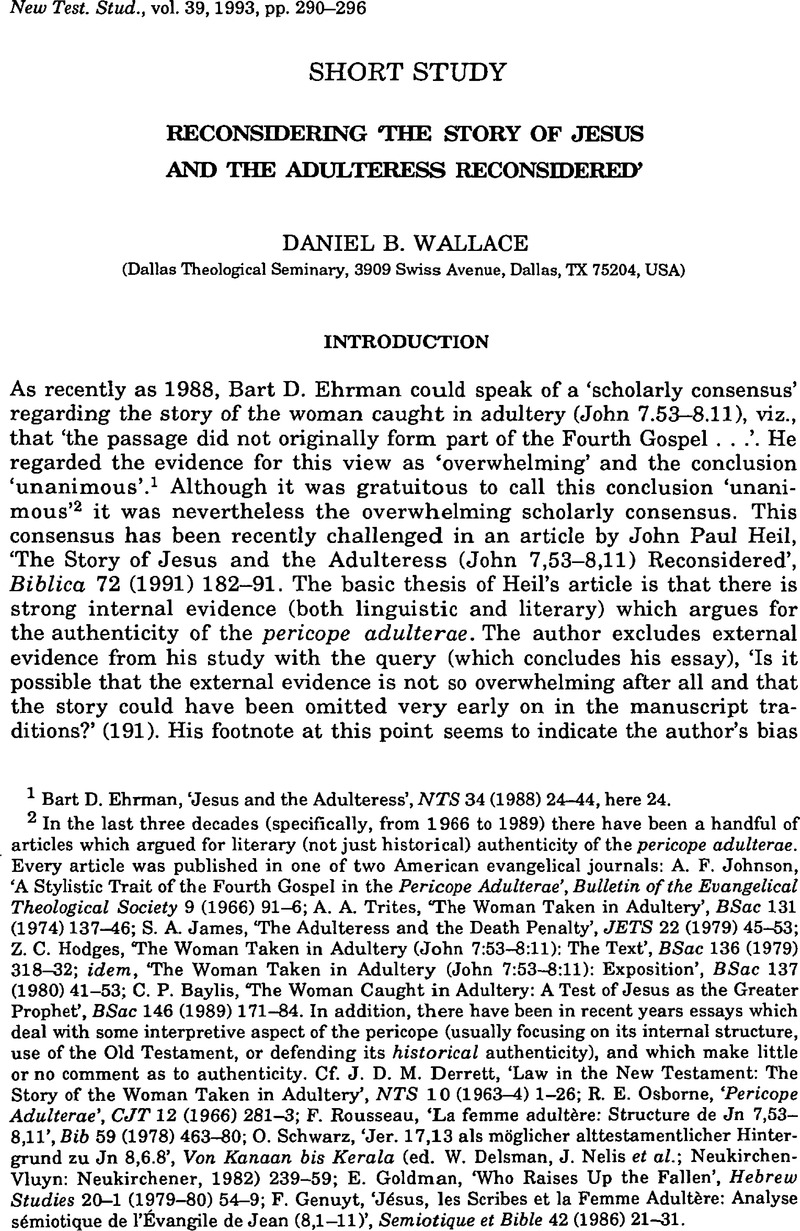Published online by Cambridge University Press: 05 February 2009

1 Ehrman, Bart D., ‘Jesus and the Adulteress’, NTS 34 (1988) 24–44, here 24.CrossRefGoogle Scholar
2 In the last three decades (specifically, from 1966 to 1989) there have been a handful of articles which argued for literary (not just historical) authenticity of the pericope adulterae. Every article was published in one of two American evangelical journals: Johnson, A. F., ‘A Stylistic Trait of the Fourth Gospel in the Pericope Adulterae’, Bulletin of the Evangelical Theological Society 9 (1966) 91–6Google Scholar; Trites, A. A., ‘The Woman Taken in Adultery’, BSac 131 (1974) 137–16Google Scholar; James, S. A., ‘The Adulteress and the Death Penalty’, JETS 22 (1979) 45–53Google Scholar; Hodges, Z. C., ‘The Woman Taken in Adultery (John 7:53–8:11): The Text’, BSac 136 (1979) 318–32Google Scholar; idem, ‘The Woman Taken in Adultery (John 7:53–8:11): Exposition’, BSac 137 (1980) 41–53; Baylis, C. P., ‘The Woman Caught in Adultery: A Test of Jesus as the Greater Prophet’, BSac 146 (1989) 171–84Google Scholar. In addition, there have been in recent years essays which deal with some interpretive aspect of the pericope (usually focusing on its internal structure, use of the Old Testament, or defending its historical authenticity), and which make little or no comment as to authenticity. Cf. Derrett, J. D. M., ‘Law in the New Testament: The Story of the Woman Taken in Adultery’, NTS 10 (1963–1964) 1–26CrossRefGoogle Scholar; Osborne, R. E., ‘Pericope Adulterae’, CJT 12 (1966) 281–3Google Scholar; Rousseau, F., ‘La femme adultère: Structure de Jn 7,53–8,11’, Bib 59 (1978) 463–80Google Scholar; Schwarz, O., ‘Jer. 17,13 als möglicher alttestamentlicher Hintergrund zu Jn 8,6.8’, Von Kanaan bis Kerala (ed. Delsman, W., Nelis, J. et al. ; Neukirchen-Vluyn: Neukirchener, 1982) 239–59Google Scholar; Goldman, E., ‘Who Raises Up the Fallen’, Hebrew Studies 20–1 (1979–1980) 54–9Google Scholar; Genuyt, F., ‘Jésus, les Scribes et la Femme Adultère: Analyse sémiotique de l'Évangile de Jean (8,1–11)’, Semiotique et Bible 42 (1986) 21–31.Google Scholar
3 For documentation and a critique of this approach, see Wallace, Daniel B., ‘Inspiration, Preservation, and New Testament Textual Criticism’, New Testament Essays in Honor of Homer A. Kent, Jr. (Winona Lake, IN: BMH Books, 1991) 69–102Google Scholar; reprinted in GTJ 12.1 (1991) 21–50.Google Scholar
4 Heil, 183–5.
5 Metzger, Bruce M., A Textual Commentary on the Greek New Testament (New York: United Bible Societies, 1971)Google Scholar, lists five places: after 7.52; after 7.36; after 7.44; after 21.25; and after Luke 21.38. Codex 115 (a tenth- or twelfth-century minuscule, which may be of the ‘Western’ text) may be cited as giving a sixth location: after 8.12. The scribe of 115 wrote out 7.52, then 8.12, then the pericope (with some interesting variations), followed by 8.12 again. For a ‘rediscovery’ of this MS, as well as its textual affinities, cf. Greene, R. Elliott, ‘The Significance of Codex 115 in Modern New Testament Textual Criticism’ (Th.M. thesis, Dallas Theological Seminary, 1992).Google Scholar
6 Heil, 184.
7 Cf. especially Bart D. Ehrman (n. 1 above), for an illuminating suggestion as to how the pericope adulterae came to be in its present form and why it cannot be taken in toto as an authentic agraphon.
8 Cf. other confrontations initiated by the Pharisees against Jesus, with similar editorial comments, e.g., Mark 3.2 (and parallels); 8.11 (and parallels); 10.2 (and parallels); 12.13 (and parallels).
9 Cf. Mark 2.27–8; 3.2; 7.14–19; 10.2.
10 Westcott, B. F., The Gospel according to St John: the Greek Text with Introduction and Notes (London: John Murray, 1908), 2.386.Google Scholar
11 Cf. also 12.47.
12 Still, the general theme of judgment is noticeable. Yet, as several scholars have pointed out, this motif in John 7–8 may well be the reason why the pericope adulterae found a home in this passage in a very early period of transmission. Gary M. Burge, for example, has argued as follows: ‘Why the passage landed in its traditional place may be easier to explain. The theme of Jesus' discourse in 8:14ff. turns on judgment: Jesus judges no one (8:15). Our text may have been attracted to this setting as a brilliant example of just this absence of judgment in Jesus …’ (‘A Specific Problem in the New Testament Text and Canon: The Woman Caught in Adultery (John 7:53–8:11))’, JETS 27 (1984) 141–8, here 144.Google Scholar
13 Contrasted with his brief treatment on linguistic evidence against authenticity.
14 Burge, ‘Specific Problem’, 144.
15 See, for a succinct and quite accessible presentation of the data, Metzger's Textual Commentary, 219–23.
16 Ibid., 221.